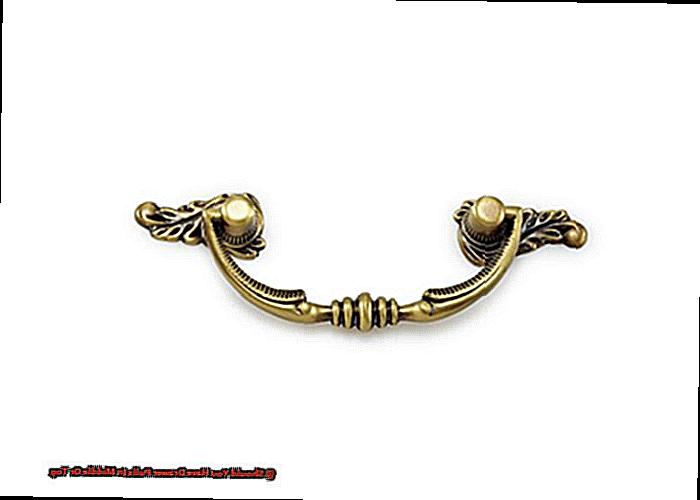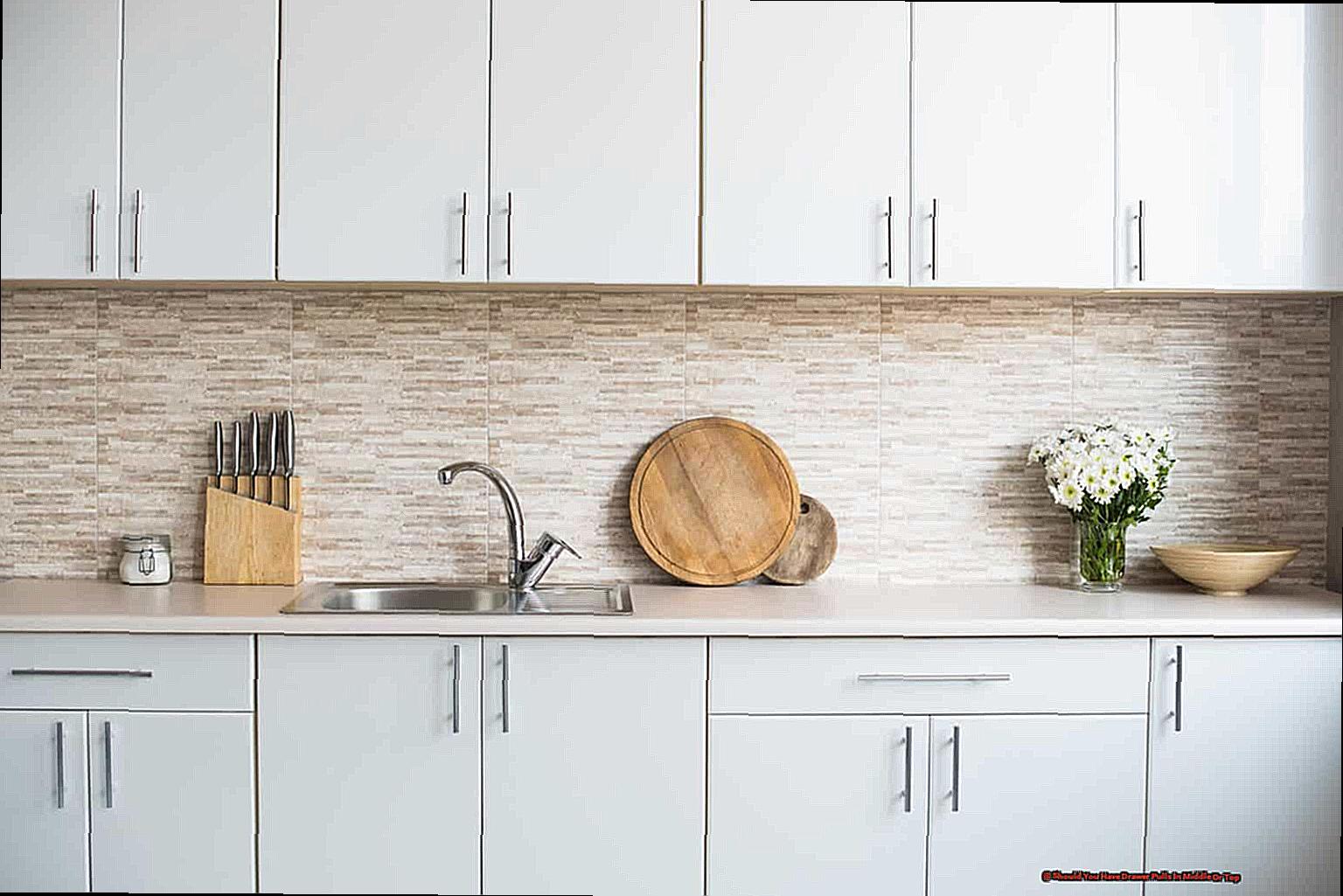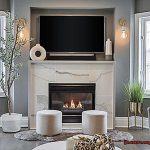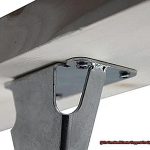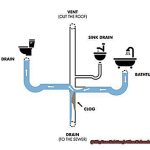Are you in the midst of a home renovation or simply looking to give your cabinets a quick refresh? One important decision to make is where to place your drawer pulls. It may seem like a small detail, but the placement of these handles can greatly impact the overall aesthetic and functionality of your space. In this blog post, we’ll delve into the debate between placing drawer pulls in the middle or at the top, and provide some key points to consider before making your decision.
The traditional placement for drawer pulls is in the middle, but as design trends evolve, many are opting for a more modern approach by placing them at the top. This creates a sleek and minimalist look that can add a touch of elegance to any room. Not only does it give off a contemporary vibe, but it also allows for easier access and a more comfortable grip when opening drawers.
However, there are still benefits to sticking with tradition and placing drawer pulls in the middle. This can create a more traditional or classic feel, which may be better suited for certain styles of homes. It also provides a balanced look when paired with other hardware such as knobs or hinges.
When deciding on placement, it’s important to consider the size and style of your cabinets. Larger drawers may benefit from being pulled from the top while smaller drawers may look better with centered pulls. Additionally, think about how you want your space to feel – do you prefer a more modern or traditional aesthetic?
Ultimately, there is no right or wrong answer when it comes to drawer pull placement. It’s all about personal preference and what works best for you and your space.
So, go ahead, experiment with different placements and find what feels right for your home. After all, it’s the little details that make all the difference in creating a beautiful and functional living space.
Contents
- 1 Where do drawer pulls go on cabinets?
- 2 Where do you put cabinet pulls on Shaker drawers?
- 3 How long should cabinet pulls be?
- 4 Do shaker cabinets need hardware?
- 5 How do you install cup pulls on Shaker cabinets?
- 6 How do you put cup handles on drawers?
- 7 What size pulls for 42 inch cabinets?
- 8 What is the rule of thumb for cabinet hardware?
- 9 What is the most common drawer pull size?
- 10 How do you install drawer pulls without a jig?
- 11 Conclusion
Where do drawer pulls go on cabinets?
When it comes to cabinet hardware, drawer pulls are a key component that can make all the difference in the overall look and functionality of your cabinets. The question is, where should drawer pulls go on cabinets? While there are varying opinions on this matter, the most recommended placement is in the middle, also known as “centered pull placement.” This means that the pull is positioned vertically in the center of the drawer or door, with equal distance from each edge. While some may argue for top pulls, centered pulls offer a more balanced and symmetrical appearance, making them the preferred choice for most cabinets.
But it’s not just about aesthetics; centered pulls also offer better stability, weight distribution, and durability compared to top pulls. With their placement in the middle, they can better handle the weight and pressure of pulling open drawers and doors. This makes them a more practical option for everyday use.
Ultimately, the decision on where to place drawer pulls on your cabinets should be based on personal preference and what works best for your specific cabinets. Each kitchen or room may have unique features or layouts that may call for different pull placements. So, take into consideration both style and function when deciding where to put your drawer pulls.
Where do you put cabinet pulls on Shaker drawers?
The placement of cabinet pulls on Shaker drawers is a crucial consideration, and it is recommended to place them 2-4 inches from the cabinet door, in the middle of the drawer front. To ensure a cohesive and symmetrical look, it is also important to take into account the bottom of the panel when determining placement.
| Type of Pull | Recommended Distance from Cabinet Door | Placement on Drawer Front |
| Knob | 2-4 inches | Centered in middle of drawer front |
| Pull Handle (length andlt; 4 inches) | 2-4 inches | Centered in middle of drawer front |
| Oversized Pull Handle (length andgt; 4 inches) | 2-4 inches | Centered in middle of drawer front |
| Pull Handle (length andgt;= 1/3 cabinet width) | N/A, must be at least 1/3 of cabinet width | Centered in middle of drawer front |
| Pull Handle (length andlt; 1/3 cabinet width) | N/A, must be at least 1/3 of cabinet width | Centered in middle of drawer front |
| Pull Handle (length andgt;= 2/3 cabinet width) | N/A, must be less than 2/3 of cabinet width or greater | Centered in middle of drawer front |
| Pull Handle (length andlt; 2/3 cabinet width) | N/A, must be less than 2/3 of cabinet width or greater | Centered in middle of drawer front |
| Pull Handle (length andlt;= 1/2 cabinet width) | N/A, must be centered in middle of inset panel | Horizontally centered in middle of inset panel |
| Pull Handle (length andgt; 1/2 cabinet width) | N/A, must be centered in middle of inset panel | Horizontally centered in middle of inset panel |
In the process of selecting the appropriate size for your cabinet pulls, it is vital to take into consideration the size and design of your cabinets.
How long should cabinet pulls be?
When selecting cabinet pulls, one must take into account the size of the cabinet as it greatly affects the overall appearance and functionality. To ensure proper placement and sizing, there are some general guidelines to follow.
For standard-sized cabinets with drawers up to 30 inches wide or doors up to 48 inches tall, pulls that are 3-4 inches long are typically recommended. These sizes are visually balanced on standard-sized cabinets and provide enough space for a comfortable grip.
For larger cabinetry with drawers over 30 inches or doors taller than 48 inches, single pulls ranging from 5-8 inches in length may be a better choice as they appear more proportionate and offer ample space for a comfortable grip.
It is advisable to purchase pulls that measure 2.5-3 inches from the center of the pull post to the ends of the pull. This measurement allows for enough room for your fingers to grasp the pull without being too small or too large.
The overall length of the pull should also be taken into consideration when choosing cabinet pulls. As a general rule, the pull should not exceed one-third of the height of the cabinet door or one-half of the width of the drawer. This ensures that the pulls do not overpower or appear disproportionate to the size of your cabinets.
Lastly, it is important to note that the standard size for cabinet pulls is typically 3 inches from the center of the screw holes to the outside edge of the handle. This is a commonly used measurement by most manufacturers and maintains consistency if using multiple pulls in your kitchen or bathroom.
Do shaker cabinets need hardware?
The hardware selected for shaker cabinets greatly influences the overall appearance and atmosphere of your kitchen or bathroom. Although shaker cabinets are renowned for their simplistic, uncluttered lines and minimalist design, hardware can infuse a touch of character and flair into these classic cabinets. So, do shaker cabinets really require hardware?
The answer is subjective and depends on personal preference and the desired aesthetic for your space. However, several popular types of hardware are commonly used for shaker cabinets.
Basic, rounded knobs and pulls:
One option for shaker cabinets is to use basic, rounded knobs crafted from wood. These knobs can be left unfinished to maintain the natural wood appearance of the cabinets or painted/stained to match the rest of the kitchen. Similarly, pulls with a simple, rounded design can also be utilized for a more streamlined look.
Elaborate hardware:
For those seeking to add a touch of opulence to their shaker cabinets, elaborate hardware can be an excellent choice. Brass or bronze knobs and pulls with intricate designs can elevate the look of shaker cabinets and add a touch of elegance to the space.
Knobs and pulls:
Both knobs and pulls can be used for shaker cabinets, but they serve different purposes. Knobs are typically utilized for cabinet doors, while pulls are employed for both doors and drawers. When selecting hardware, consider the size and function of your cabinets to determine which option will work best.
Popular hardware styles:
Some in-demand hardware styles for shaker cabinets include brushed gold or champagne handles, nickel knobs, flat bar pulls, accented wire pulls, arced and footed pull bars, glass knobs, and vintage-style glass. Depending on your overall design aesthetic, these styles can add a modern or vintage touch to your shaker cabinets.
When choosing hardware for your shaker cabinets, consider the size and proportion of your cabinets. Adhering to general guidelines such as 3-4 inch pulls for standard-sized cabinets and 5-8 inch pulls for larger cabinetry, as well as keeping the hardware measurement to 2.5-3 inches from the center of the pull post to the ends, can ensure a cohesive and visually appealing look.
How do you install cup pulls on Shaker cabinets?
If you wish to achieve a clean and professional look when installing cup pulls on your Shaker cabinets, it’s essential to follow the necessary steps correctly. Here’s how you can do it effectively:
- Prepare your tools: Before proceeding with the installation, make sure you have all the necessary tools ready. These include a drill, drill bits, and a piece of cardboard cut to the exact size of your drawer front.
- Measure and mark precisely: To avoid any mistakes and ensure accuracy, measure twice before drilling. Use a ruler or measuring tape to mark the center of your drawer front with a pencil.
- Create a template for precise installation: To achieve even and precise placement of cup pulls, it’s best to create a template using a piece of cardboard. Cut it to the same size as your drawer front and mark where you want your pulls to be placed.
- Use painters tape as a guide: Place painters tape over the center line marked on your drawer front. This will serve as a guide for aligning your template accurately.
- Drill holes with precision: Place the template over the painters tape and use it as a guide to mark where you need to drill holes. Use a drill bit slightly larger than the screw size for better accuracy.
- Properly install cup pulls: Once all holes are drilled, you can now install your cup pulls by inserting the screws through the holes in the front of your drawer and tightening them with a screwdriver.
- Consider faux drawers carefully: If your cabinet has faux drawers, you must consider whether or not to add hardware. In this case, it’s best to consult with a professional or take into account any future renovation plans.
By following these steps diligently, you can easily install cup pulls on your Shaker cabinets for a clean and professional look. Remember to measure carefully and use a template for more precise placement.
How do you put cup handles on drawers?
The optimal technique for attaching cup handles to drawers varies based on individual preference and the specific design and purpose of the drawers.
On the contrary, placing them at the top can offer increased stability and a more secure hold for horizontal drawers.
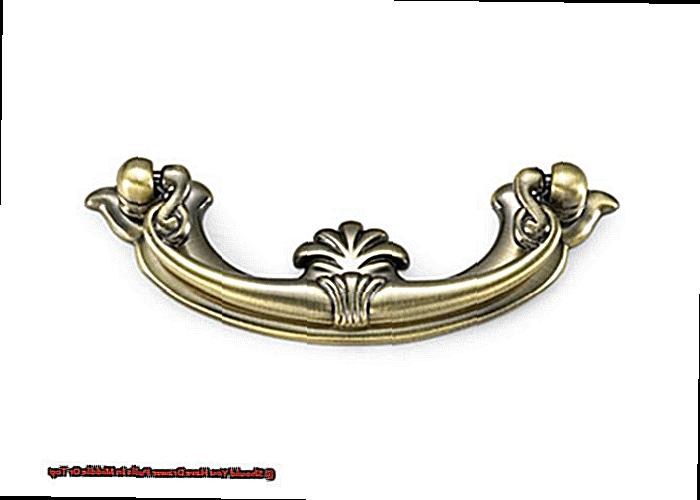
What size pulls for 42 inch cabinets?
When it comes to the ideal size for drawer pulls on 42 inch cabinets, there are several options to consider.
For a strong and stable grip, pulls that are around 5 inches, 96mm or 3 ¾ inches, 8mm or 5 inches, 60mm or 6 ¼ inches in size would be most suitable. However, the height and functionality of the cabinets should also be taken into account when selecting the appropriate size.
For taller cabinets, longer pulls may be necessary to ensure ease of use. Ultimately, the size of the pulls will depend on personal preference and the overall look of the cabinets.
It is recommended to experiment with different sizes and styles to find the perfect fit for your specific cabinets.
What is the rule of thumb for cabinet hardware?
When it comes to the placement of drawer pulls on cabinets, there is a general guideline to follow. The rule of thumb is to center the pulls on the outside edge of drawers and align them with the center line of the drawer. For larger drawers, it is recommended to use two or three pulls, spaced evenly for optimal functionality.
However, depending on the type of pull being used, the specific placement may vary. For instance, cup pulls, which are often used on larger drawers, should be installed on the top third of the cabinet drawer and centered in the second column. This allows for easy access and a comfortable grip when opening the drawer.
On the other hand, finger pulls, also known as tab pulls, should be installed on the top edge of the drawer and centered in the second column. These pulls are more discreet and provide a sleek look to cabinets.
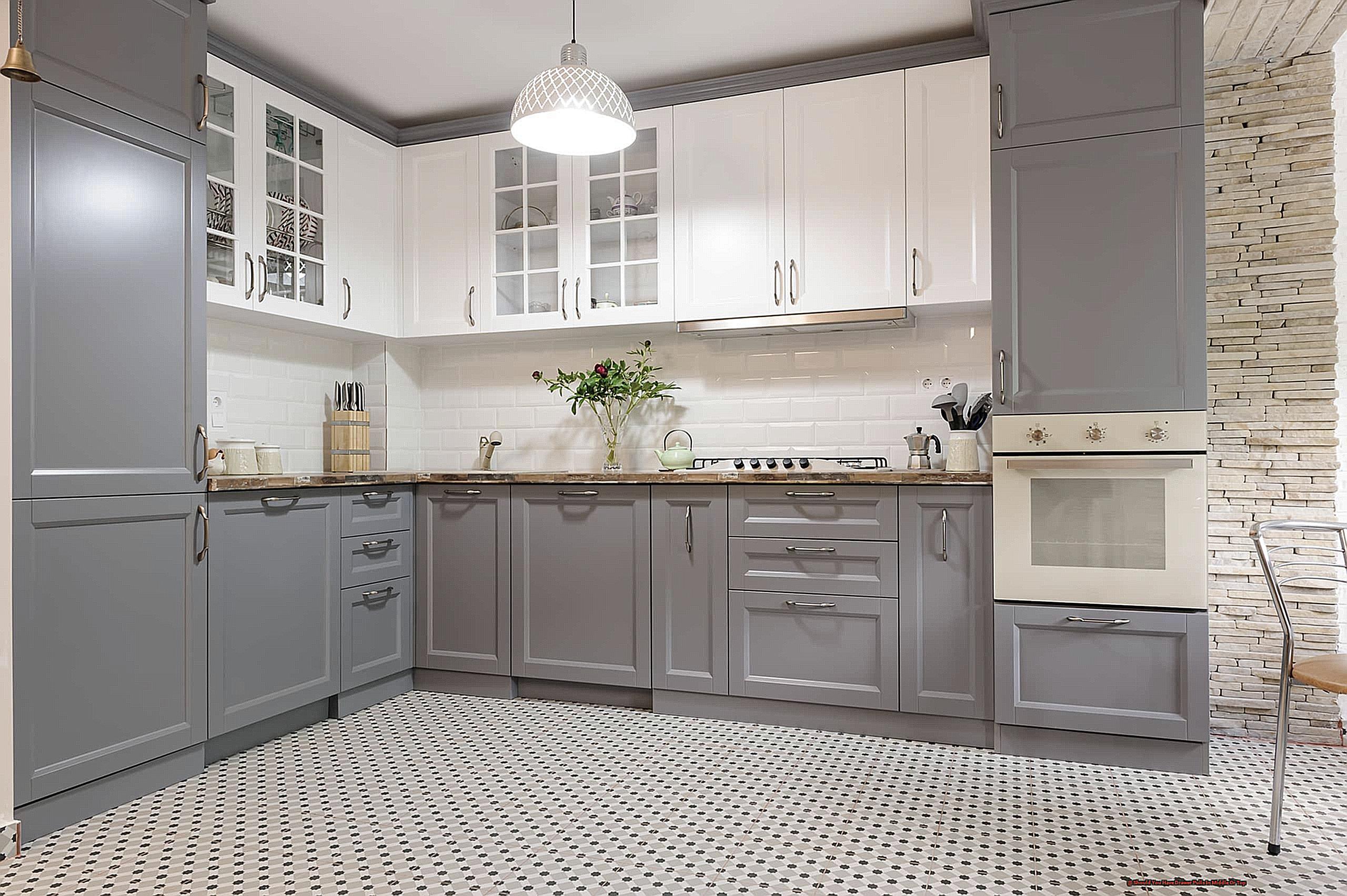
Traditional knobs are another popular option for cabinet hardware. For these, it is recommended to place them centered in the middle of the drawer or cabinet door. This placement ensures functionality and a visually appealing look.
Ultimately, when deciding on the placement of drawer pulls on cabinets, it is important to consider personal preference and functionality. Experimenting with different options can help determine what works best for your specific cabinets and needs. Factors such as grip strength, cabinet height, and personal style should also be taken into consideration.
What is the most common drawer pull size?
The most common size for drawer pulls is typically between 3 to 5 inches, with the availability of both smaller and larger sizes for custom orders. Drawer pulls come in a standard size range of 2-1/2 to 6 inches, offering a wide selection of styles and designs to choose from.
The size of a drawer pull plays a crucial role in both its aesthetic appearance and its placement on the drawer. As mentioned earlier, the general rule of thumb is to have the pull cover at least one-third of the width of the drawer face and no more than one-half of the drawer’s height.
To better understand how the size of a drawer pull impacts its placement, let’s examine some examples:
| Drawer Size | Recommended Pull Size | Placement on Drawer |
| 4 inches | 3 inches | Centered horizontally and vertically on the face of the drawer |
| 6 inches | 4 inches | Centered horizontally and vertically on the face of the drawer, or two pulls can be used |
| 12 inches | 6 inches or two 3 inch pulls | If using one pull, it should be placed closer to the top of the drawer. If using two pulls, they should be spaced evenly apart. |
From these examples, we can see that not only does the size of a drawer pull determine the number of pulls to use, but it also dictates their placement on the drawer. It is essential to keep these guidelines in mind when selecting and installing drawer pulls to achieve a visually appealing and practical design.
How do you install drawer pulls without a jig?
While utilizing a jig is the most common and recommended approach for installing drawer pulls, there are other methods that can be used if a jig is unavailable. These methods may require more precision and patience, but can still lead to a successful installation.
Use a Straight Edge
- A straight edge can be utilized to guarantee that the pulls are installed in a straight line.
- Simply place the straight edge along the intended location of the pulls and mark the center point for each hole.
- This method works best for pulls with a single hole.
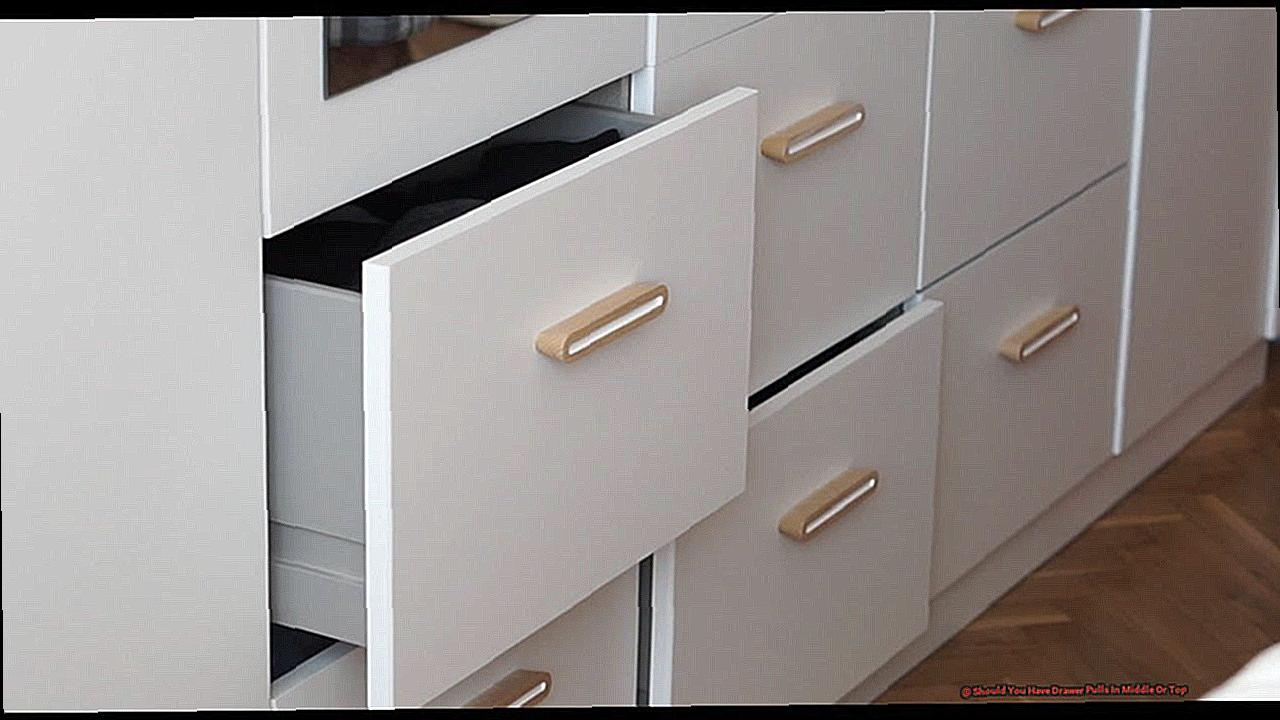
Drill and Screwdriver
- To install drawer pulls without a jig, you will need a drill, drill bit, screwdriver, and possibly another bit depending on the type of pull.
- Measure the center point of the drawer face and make a small mark.
- Using a drill bit slightly larger than the bolt diameter, drill a hole at the center point.
- If the bolt does not protrude enough, use a larger bit to create a counterbore.
- Thread on the knob or pull and tighten with a screwdriver.
Painter’s Tape Method
- For 2-hole pulls, you can utilize painter’s tape and measurements to determine the center point for each hole.
- Measure and mark the desired location of the pulls on the drawer face.
- Place strips of painter’s tape over the marks and mark the center point on the tape.
- Drill holes at these points and install the pulls.
Double Knobs
- For double knobs, find the horizontal center of the drawer face and measure from each end to determine the center point for each knob.
- Mark these points on the drawer face.
- Drill holes at these points and install the knobs.
Utilizing any of these alternative methods may require more time and precision, but can result in a successful installation even without using a jig.
Conclusion
In conclusion, the placement of drawer pulls on cabinets is a crucial decision that can greatly impact the overall look and functionality of your space. Whether you choose to go with traditional centered pulls or opt for a more modern top placement, it’s important to carefully consider the size and style of your cabinets. Additionally, don’t forget to take into account your personal preferences and desired aesthetic when making this decision.
When it comes to Shaker cabinets, hardware can add character and elevate the design of these classic pieces. From simple knobs to elaborate pulls, there are endless options to choose from based on your unique style and needs. However, proper installation is key in achieving a clean and professional look for cup pulls on Shaker cabinets.
Ultimately, the placement and installation of hardware is all about finding what works best for you and your space. Don’t be afraid to experiment and think outside the box when it comes to choosing the perfect hardware for your home renovation or cabinet refresh. After all, it’s often the little details like drawer pulls that make all the difference in creating a beautiful and functional living space.
